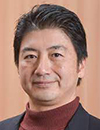Tutorial 3

Smart Sensors by Intelligent Materials
Hirofumi Tanaka
Kyushu Institute of Technology
Abstract: Sensing technology is getting important in the autonomous robot system because of developing AI technology. To detect all kinds of senses, such as the traditional five senses of the human being (namely sight, smell, touch, taste, and hearing) is demanded to close the robot system to human beings. For example, tactile sensors are used for variable purposes presently. For the automatic harvesting robots, a soft sensor is required to avoid the damage of fruits or vegetables when ripeness measurement is performed by the direct touch of the sensors to products. Also, the sensitivity of the sensor is necessary to be identified the ripeness of fruits or vegetables. Fabricating a flexible/sensitive sensor by molding CNT / PDMS composite material based on sugar cube was succeeded. By controlling the ratio of CNT / PDMS, an effective detection unit was obtained for measuring the change in tomato hardness with time.
In the present tutorial, I would like to introduce how such a sensing technology, especially tactile sensing, was developed and have achieved to a present sensing technology which is conducting to "Haptic technology" known as kinaesthetic communication or 3D touch, which refers to any technology that can create an experience of touch by applying forces, vibrations, or motions to the user. I also introduce a present a new "intelligent" sensing method using reservoir computing (RC) devices. The RC is a framework for computation derived from recurrent neural network theory that maps input signals into higher dimensional computational spaces through the dynamics of a fixed, non-linear system called a reservoir. After the input signal is fed into the reservoir, which is treated as a "black box," a simple readout mechanism is trained to read the state of the reservoir and map it to the desired output. The RC is a kind of neuromorphic computing because RC is developed by mimicking brain function, such as signal feedback in the reservoir. Robust nonlinearity and memory property are needed to make use of the material as practical in-materio computing devices by nanomaterials as an innovative approach for an effective information processing system. To achieve the requirement, it is proposed to utilize not only a highly conductive molecular network, but Ag/Ag2S nanoparticles aggregation, CNT/polyoxometalate (POM), which contain nonlinear-conduction regions in nanoscale. Based on the previously reported theoretical model of a random network (RNW) of single-walled carbon nanotube (SWNT)/POM reservoir, I will then introduce the fabrication of a physical reservoir computing (RC) device using RNW of SWNT/porphyrin-POM (Por-POM) complex. I will also introduce that we could generate multiple non-linear high dimensional outputs and train them successively to achieve the classification of different objects by inputting time-series tactile grasping object data from Toyota Human Support Robot (HSR) into the RNW of SWNT/Por-POM reservoir.
Biography: Prof. Tanaka completed his doctorate in materials science studying the structural and magnetic properties of ferromagnetic nanoalloys at Osaka University in 1999. Then moved to RIKEN to study the conductivity of metallic nanowires with double-probe scanning tunneling microscopy as a special postdoctoral researcher. After that, he advanced the molecular-ruler method in which precise multilayers of self-assembled molecular monolayers are used as lithographic resists to yield nanostructures with precise nanometer-scale spacings as a postdoctoral researcher at the Pennsylvania State University under Prof. Paul Weiss (presently UCLA, chief editor of ACS Nano). Prof. Tanaka then joined the Research Center for Molecular-Scale Nanoscience at the Institute for Molecular Science in 2003 as an assistant professor, where he directed research in molecular electronics using carbon nanotube electrodes. He found that gold nanoparticles can switch to metallic conduction of SWNTs to semiconducting simply by nanoparticle adsorption. He has also focused on the development of atomic switches, exploring the ultimate miniaturization of electrical switches, and controlled by photo irradiation 2004-2008 in a key technology project of the Ministry of Education, Culture, Sports, Science and Technology (MEXT) and receive an excellent journal award from Japan Society of Applied Physics in 2012. He moved to department of Human Intelligence Systems, Graduate School of Life Science and Systems Engineering, Kyushu Institute of Technology (Kyutech) as a full professor in 2014 and is focusing on bio-mimic and/or neuromorphic AI electric nanodevices. He concurrently became a director of Research Center for Neuromorphic AI Hardware, Kyutech in 2020. His wide knowledge of materials from metals and inorganic materials to organic materials, and techniques on measurement and fabrication help leading efforts molecular electronics and in combining nanocarbon and nanoparticles to realize a new world of materials intelligence in nanosystems.